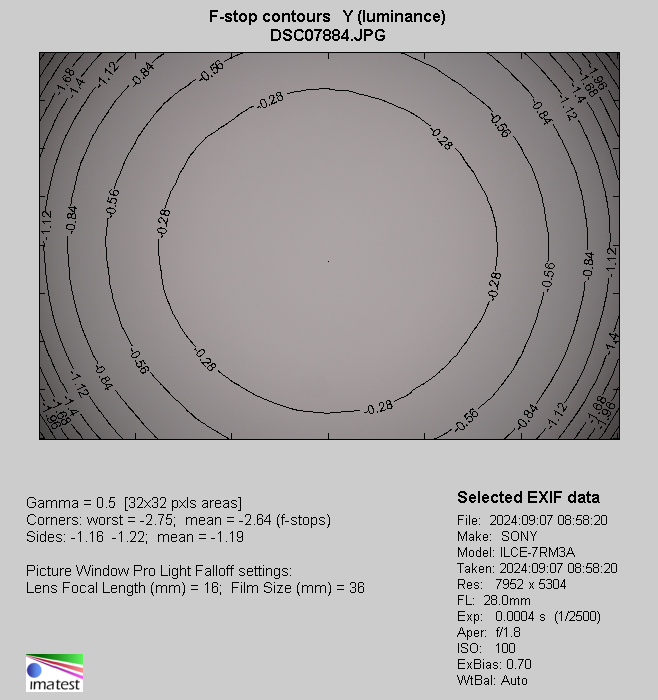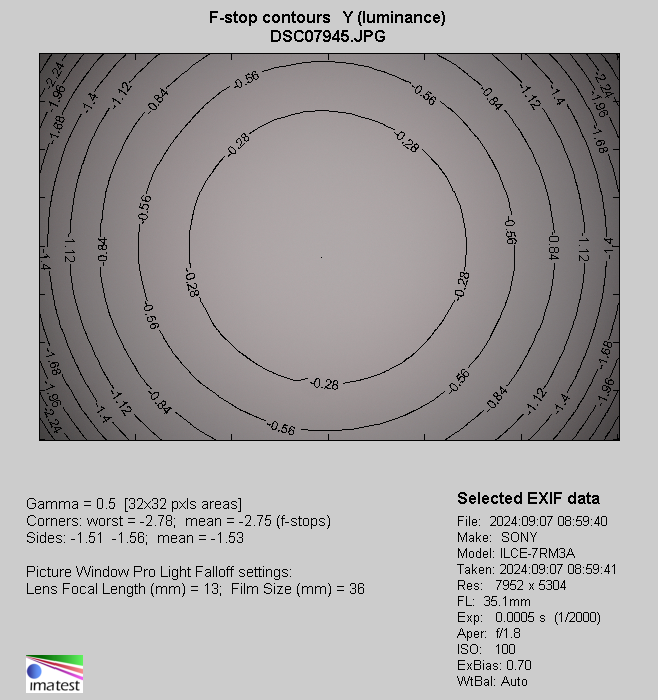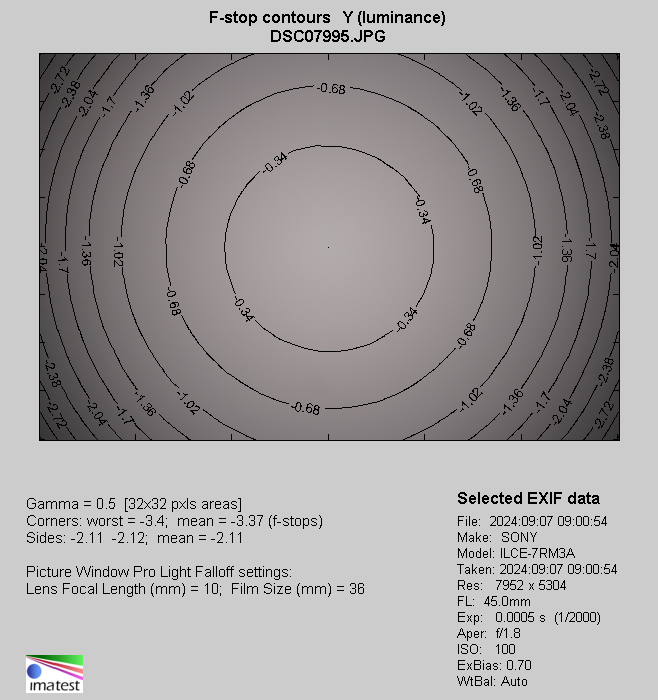Sigma A 28-45 mm f/1.8 DG DN
8. Vignetting
| A7R IIIa, APS-C, JPEG, 28 mm, f/1.8 | A7R IIIa, APS-C, JPEG, 28 mm, f/2.0 |

|

|
| A7R IIIa, APS-C, JPEG, 35 mm, f/1.8 | A7R IIIa, APS-C, JPEG, 35 mm, f/2.0 |

|

|
| A7R IIIa, APS-C, JPEG, 45 mm, f/1.8 | A7R IIIa, APS-C, JPEG, 45 mm, f/2.0 |

|

|
On the smaller APS-C sensor vignetting is almost no problem at all only at the shorter end of the focal spectrum. At 28 mm and the maximum relative aperture brightness loss in frame corners reaches 19% (-0.60 EV) and it decreases to 13% on stopping down the aperture to f/2.0. By f/2.8 this aberration disappears practically completely with a result of just 5% (-0.16 EV).
Please Support UsIf you enjoy our reviews and articles, and you want us to continue our work please, support our website by donating through PayPal. The funds are going to be used for paying our editorial team, renting servers, and equipping our testing studio; only that way we will be able to continue providing you interesting content for free. |
- - - - - - - - - - - - - - - - - - - - - - - - - - - - - - - - - - - - - - - - - - - - - - - -
In the middle of the focal range the situation is a bit worse. By f/1.8 vignetting reaches 25% (-0.85 EV) and by f/2.0 it drops to a level of 20% (-0.65 EV). Once again by f/2.8, this aberration becomes imperceptible, decreasing to just 7% (-0.20 EV).
The highest value you see at 45 mm and here you can already speak about some noticeable problems. By f/1.8 brightness loss in frame corners amounts to 34% (-1.18 EV), by f/2.0 it decreases to 30% (-1.02 EV), and by f/2.8 it disappears practically completely, with a result of just 8% (-0.26 EV).
Let's check how the situation changes when you pass to full frame – appropriate thumbnails you can find below.
| A7R IIIa, FF, JPEG, 28 mm, f/1.8 | A7R IIIa, FF, JPEG, 28 mm, f/2.0 |

|

|
| A7R IIIa, FF, JPEG, 35 mm, f/1.8 | A7R IIIa, FF, JPEG, 35 mm, f/2.0 |

|

|
| A7R IIIa, FF, JPEG, 45 mm, f/1.8 | A7R IIIa, FF, JPEG, 45 mm, f/2.0 |

|

|
This time the aberration, described here, is far easier to notice and, like previously, it goes up with the increase of the focal length. By 28 mm and f/1.8 the light fall-off in frame corners amounts to 60% (-2.64 EV) and it decreases slightly to 55% (-2.33 EV) on slight stopping down of the aperture to f/2.0. More serious problems are still visible by f/2.8 and f/4.0 where we got the following results: 38% (−1.36 EV) and 31% (−1.09 EV) respectively. A moderate level is available by f/5.6 and f/8.0, where we measured 25% (-0.84 EV) and 21% (-0.68 EV). Even by f/11.0 and f/16.0 it would be hard to call vignetting imperceptible, with levels reaching more than a dozen percent.
After changing the focal length into 35 mm, the results are very similar. By f/1.8 vignetting is 61% (−2.75 EV), by f/2.0 it reaches 58% (−2.51 EV), and by f/2.8 it drops to 36% (−1.27 EV). By f/4.0 and f/5.6 the problem still remains bothersome because we measured the following values: 24% (−0.80 EV) and 18% (-0.58 EV) respectively. Further stopping down doesn't produce any measurable effects.
The weakest results you see at the maximum focal length – and here the problem becomes really acute. It can be noticed that, despite significant dimensions of the lens, some problems cannot be avoided. I suppose the optics constructors, being only too aware of this truth, decided to limit the focal range to 45 mm and didn't drag it forcibly to 50 mm.
At the maximum relative aperture you have to make do with a huge loss of light in frame corners, that of 69% (-3.37 EV). It decreases slightly to 66% (-3.14 EV) on stopping down the aperture to f/2.0. By f/2.8 you still deal with a high level of 45% (-1.74 EV) and only by applying the f/4.0 aperture you are able to reduce vignetting to a moderate value of 26% (-0.86 EV). By f/5.6 you see some further drop to 19% (-0.61 EV), and then stopping down doesn't produce any distinct effects.
| Sony A7R IIIa, 28 mm, JPEG, f/1.8 |
 |
| Sony A7R IIIa, 35 mm, JPEG, f/1.8 |
 |
| Sony A7R IIIa, 45 mm, JPEG, f/1.8 |
 |






